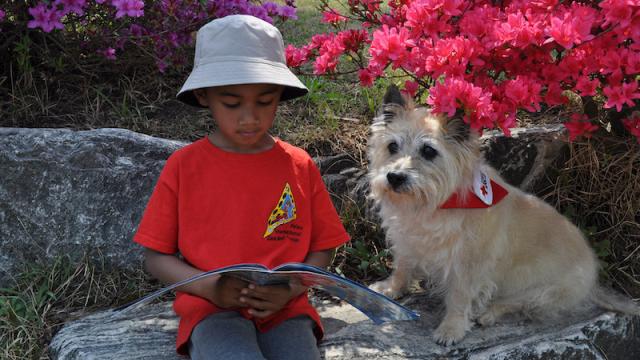Dogs are pros at making you feel better when you’ve had a bad day or you’re couch-bound while sick, and they can help other people feel the same expansive dog love with a little training. Training your dog to be a therapy dog means they will be able bring joy to children who are stuck in the hospital, provide companionship for older folks, and comfort those with disabilities.
Image from usaghumphreys.
What Types of Dogs Are Good for Therapy Training
The first step when thinking about certifying your pup as a therapy dog is to find out if they’re the right type. Jennifer Henley, PhD, the manager of the Animal Assisted Therapy program at the San Francisco SPCA, says that personality matters much more than breed when it comes to dogs that are great at therapy. Your dog should:
- Enjoy meeting new people
- Have no negative history (like nipping or biting)
- Follow commands, such as sit, leave it, stay and down
- Be OK with new noises, smells and environments
- Be able to be calm and sit still during visits
Training and being a therapy dog is a lot of work for both of you, so your dog should not only like working, but should like this type of work. For example, if your dog likes work such as fetching, herding or tracking, they may not be as suitable for therapy since it involves ignoring distractions and following commands promptly. Dogs that are known for their intelligence and are easy to train, such as guard dogs or terriers, may take faster to therapy training and be better suited.
Henley recommends knowing dogs’ boundaries so that if it turns out they don’t really like therapy work, you can find another way to help your community, such as joining a volunteer search and rescue group.
Whom Your Dog Will Help
Most people know that therapy dogs and their owners do good by visiting those in need of companionship, but you might not realise how big of an impact you can have. Henley describes the main benefit of becoming an animal therapy volunteer:
It is an honour to help someone in such times of need and being a part of that, and knowing your dog brought joy, comfort, peace, the motivation to do physical therapy, etc, is incredibly rewarding.
You have a ton of options when it comes to who you and your dog volunteer to help with therapy visits. Here are some common opportunities you likely have nearby:
- Hospitals: Children, as well as other patients, need a friendly face to brighten their day.
- Nursing homes and senior centres: Bring comfort to older people. Especially great for lap-sized dogs.
- Libraries and schools: Help kids practise reading by providing a non-judgemental fluffy audience.
Check with your local libraries, community centres and shelters to see if there are other programs you and your dog can join.
How to Get Your Dog Trained and Certified
You’ll likely need to invest quite a bit of time and effort into getting your dog trained and certified for therapy work, but the happiness you bring to those in need can be well worth it. The exact evaluation exam and certification standards vary depending on what organisation you’re being certified by, but the training typically involves:
- Training classes (usually 4+ hours over several weeks)
- Your dog demonstrating the ability to follow a series of commands (sit, stay, off, leave it, say hi)
- Monitored visits to observe how your dog does
- Proof of health from a vet (you may have to re-submit this annually)
You may also have the option to go through several levels of certification as your dog adds more therapy visitation experience under their collar. Some organisations offering therapy training and certification programs in Australia include Lead The Way and Therapy Dogs Australia.
Besides performing a valuable service to your community, going through therapy dog certification, training, and actual volunteering can strengthen the bond between you and your dog.

Comments